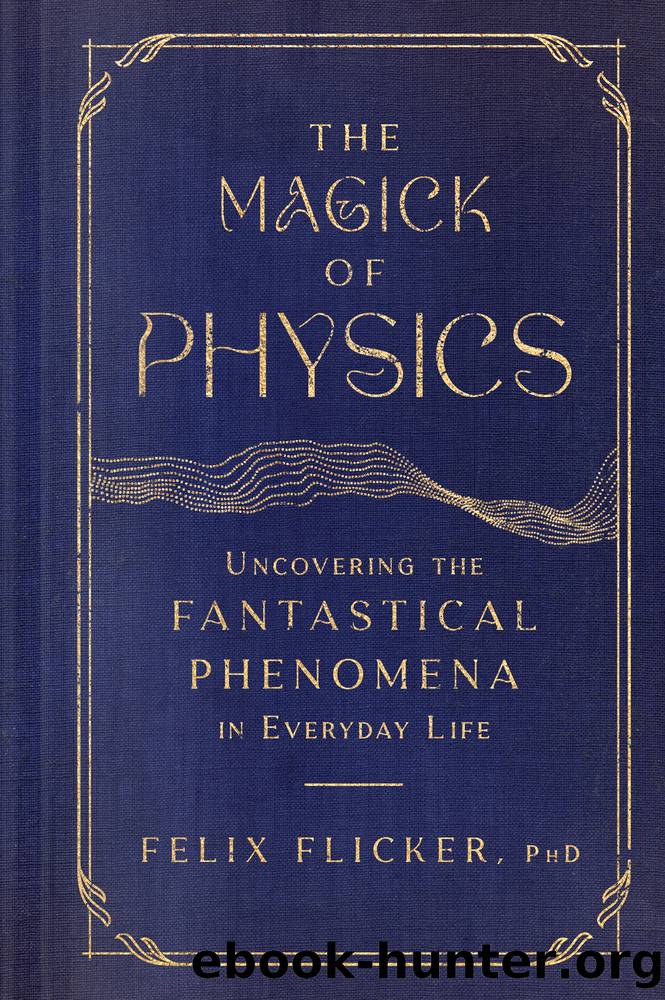The Magick of Physics: Uncovering the Fantastical Phenomena in Everyday Life by Felix Flicker

Author:Felix Flicker
Language: eng
Format: epub
Publisher: Simon & Schuster
Published: 2023-03-21T00:00:00+00:00
The Fields That We Know
The 2004 film I Huckabees contains a scene in which Bernard, an âexistentialist detective,â outlines his philosophy of reality using a blanket. The blanket, he explains, represents everything: this part, he says, is himself; this is his wife and colleague Vivian; this is a hammer; this, the Eiffel Tower; this, a war. Everything, he claims, is the same, even if itâs different. Even in the context of the film Bernardâs view is shown not to be the whole truth. But nevertheless, lifting parts of a blanket and declaring them to be different but ultimately part of the same blanket captures the essence of modern physics as depicted by quantum field theory.
To my mind, the easiest way to get an idea of quantum field theory is to return to the idea of phonons. Recall that these are the quantum description of sound traveling through a crystal. A simple classical analogy has atoms represented by little balls, each connected to its nearest neighbors by springs (Figure 20). To simplify, letâs imagine a two-dimensional crystal, a sheet of material a single atom thickâlike the thinnest possible blanket or the elastic surface of a trampoline. The reason balls and springs are a good model is that each atom is attracted to its neighbors by their chemical bonds but doesnât want to get too close, because then they begin to feel the repulsion of their positive nuclei. Now, the atoms are not fixed; they can wobble as the springs stretch and shrink. Tug one side of the crystal-sheet and vibrations spread throughout. Lifting one ball pulls up its neighbors by the springs connecting them, and those neighbors pull their neighbors, and so on. If you let go, the balls start wobbling, and vibrations spread out across the trampoline. Now, if the balls and springs are small enough (and remember theyâre approximating atoms and their atomic bonds), and you blur your eyes a bit, you just see a continuous surface with a smoothly varying height. This is a field: a description of a physical process that involves assigning a quantity (height in this case) at every point in space. The height of the trampoline at an instant in time and a point in space indicates how much the ball at that point is wobbling back and forth about its resting position.
The name âfieldâ was proposed by Michael Faraday in 1849 when thinking about magnetic fields (which are another exampleâthe magnetic field describes the direction of magnetic field lines at every point in space). Let me clarify the various metaphors, since âfieldâ is itself metaphorical. The balls and springs are a classical model of atoms and their atomic bonds. Weâre thinking of them as a two-dimensional sheet for simplicity (and to enhance the analogy), but the same would work for real three-dimensional materials. Blur your eyes, and they look like the surface of a trampoline. At any given instant a snapshot of the trampoline looks like a set of rolling fields. Chuck a blanket on the trampoline, or a picnic blanket in the field, and it takes the shape of the surface.
Download
This site does not store any files on its server. We only index and link to content provided by other sites. Please contact the content providers to delete copyright contents if any and email us, we'll remove relevant links or contents immediately.
The Complete Stick Figure Physics Tutorials by Allen Sarah(7307)
Secrets of Antigravity Propulsion: Tesla, UFOs, and Classified Aerospace Technology by Ph.D. Paul A. Laviolette(5309)
Thing Explainer by Randall Munroe(3877)
The River of Consciousness by Oliver Sacks(3539)
The Order of Time by Carlo Rovelli(3145)
How To by Randall Munroe(3034)
A Brief History of Time by Stephen Hawking(2960)
I Live in the Future & Here's How It Works by Nick Bilton(2935)
The Great Unknown by Marcus du Sautoy(2646)
What If?: Serious Scientific Answers to Absurd Hypothetical Questions by Randall Munroe(2637)
Midnight in Chernobyl by Adam Higginbotham(2483)
Blockchain: Ultimate Step By Step Guide To Understanding Blockchain Technology, Bitcoin Creation, and the future of Money (Novice to Expert) by Keizer Söze(2445)
Networks: An Introduction by Newman Mark(2360)
The Meaning of it All by Richard Feynman(2300)
Easy Electronics by Charles Platt(2281)
The Tao of Physics by Fritjof Capra(2229)
Midnight in Chernobyl: The Untold Story of the World's Greatest Nuclear Disaster by Adam Higginbotham(2177)
When by Daniel H Pink(2082)
Introducing Relativity by Bruce Bassett(2076)
